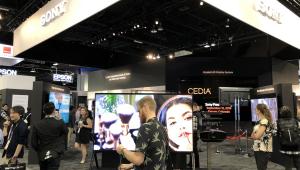The Right Stuff and Dolby TrueHD Advanced 96kHz

Last year, Dolby announced a new variation on its TrueHD audio codec for Blu-ray, a process that involves 96kHz upsampling of the audio source file. Its purpose is to eliminate some common digital artifacts (see Geoff Morrison's article for a more detailed explanation of how this works).
The process has only been used to date, however, on a few releases. The Right Stuff, originally released on Blu-ray in November 2013, was supposed to be one them. Through a mastering error, however, the process was not engaged. Now, two months later, Warner Brothers has re-released the film with the 96kHz upsampled soundtrack.
Your best bet in making sure you get the newest version is the prominent “Advanced 96kHz gold sticker” on the outside of the package’s shrink wrap. Inside, you’ll have to look at the inner ring on data side (not the label side) of the disc to physically distinguish between the original release and the newer version. There you’ll find two numbers in white. Look between them and there are other numbers in a black. On the older disc this number ends with 42740.1. On the 96kHz Advanced upsampled disc it’s 42740.2. You may need a good magnifying glass for this.
I set up a direct AB test to compare the two versions, which proved more difficult than I anticipated. To keep the contest as close as possible, I used two Oppo universal players, but not precisely the same models: a BDP-95 for the original and a BDP-103 for the 96kHz Advanced upsampled disc. I used the HDMI outputs for both the audio and video, leaving my long-in-the-tooth but still trusty Integra DTC-9.8 pre-pro to do the D/A heavy lifting. According to Dolby, nothing special is required on the playback side to make use of their new process, apart from the capability to decode ordinary Dolby TrueHD. All of the 96kHz jiggery-pokery happens in the mastering of the disc itself.
The first difference I noticed was a nearly 6dB difference in playback level, with the 96kHz version the louder. I later determined that about 4.5dB of this difference was on the new disc itself, with another roughly 1.5dB from a slightly higher gain in the BDP-103’s HDMI output. This produced a total discrepancy in gain of nearly 6dB in favor of the louder 96kHz version.
A level difference this large, of course, won’t do for an AB comparison. To account for it I quickly raised or lowered the volume by 5-6 dB during the 3-4 seconds it took the Integra to re-establish a lock on when switching between the players. But I wasn’t entirely satisfied that I had a technically exact level match. Such a perfect match was impossible, since we know of no consumer disc that has identical, level-matched test tones mastered with tracks having both Advanced 96kHz Upsampling and the conventional 48kHz audio processingthe only way to be sure.
What I did notice, after as near a level match as possible, was an enhanced top end airiness on the 96kHz version. This was most beneficial on small audio detailsthe clicking of relays in mission control, birds twittering inside the hangar holding the F-104 that Chuck Yeager will fly in an attempt at a jet aircraft altitude record, and the music accompanying John Glenn orbiting the earth and, later, the fan dance at reception in the Houston Astrodome. The upgraded disc’s sound was less sweet overall, and slightly edgier, on both dialog and in the film’s loud, brass-heavy theme music. This was clearly in the source. The main obstacle to a definitive conclusion about the Advanced 96kHz technique was the film’s soundtrack itself. It’s a very good early ‘80s soundtrack, but an early ’80 soundtrack nonetheless.
The changes I did hear, however, made me wonder if the only changes made in producing the new transfer was the 96kHz processing, or if perhaps some added “sweetening” was also applied, perhaps equalization. If the latter were the case, it would make such comparisons meaninglessassuming we’re attempting to judge only the effect of the 96kHz processing. We have no way of knowing if there was any such additional manipulation, but it can happen even with the most innocent of intentions. (“Hey guys, we have a two month bonus; we should be able to improve on this thirty year-old soundtrack!”). In any case, be sure to account for the level difference if you have the opportunity to make a similar comparison.
Overall though, and after correcting for the level difference as closely as possible, I marginally preferred the 96kHz version. To dredge up the hoariest critical cliché, there was just a bit more “there” there. It’s certainly worth looking for the upgraded disc if you don’t already own the Blu-ray. But whether or not it would be worth buying it again if you already own it is your decision.
























































